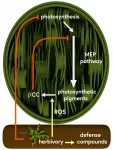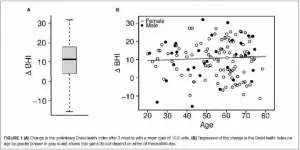(Press-News.org) In a new study in PNAS, an international team of researchers including scientists from the Max Planck Institute for Chemical Ecology has shown that Arabidopsis thaliana plants produce beta-cyclocitral when attacked by herbivores and that this volatile signal inhibits the methylerythritol 4-phosphate (MEP) pathway. The MEP pathway is instrumental in plant growth processes, such as the production of pigments for photosynthesis. In addition to down-regulating the MEP pathway, beta-cyclocitral also increases plant defenses against herbivores. Since the MEP pathway is only found in plants and microorganisms, but not animals, knowledge of a signal molecule like beta-cyclocitral opens up new possibilities for the development of herbicides or antimicrobial agents that block this pathway (Proceedings of the National Academy of Sciences of the United States of America, March 2021, doi:10.1073/pnas.2008747118).
Trade-offs between defense and growth processes in plants
Researchers have long known that plants have limited resources that they can invest in defense against enemies or in growth and reproduction, depending on their environmental conditions. Many studies have already shown that plants increase their defenses when attacked by insects producing, for example, toxins or inhibitors of digestive enzymes that harm their attackers. However, much less is known about how herbivore attack affects growth processes in the plant. "We wanted to investigate how herbivory might affect photosynthesis and the methylerythritol 4-phosphate (MEP) pathway, a pathway making metabolites for growth that is directly supplied from photosynthesis," says first author Sirsha Mitra, who had started working on this project at the Max Planck Institute and is now an assistant professor at Savitribai Phule Pune University in Pune, India.
The MEP pathway has been a research topic at the Max Planck Institute for Chemical Ecology in Jena for several years "The MEP pathway makes the building blocks for plant isoprenoids or terpenoids, a very large family of plant metabolites involved in growth, defense and signaling," says Jonathan Gershenzon, the head of the Department of Biochemistry and one of the authors.
Beta-cyclocitral activates defense and inhibits growth
The international research team, which also included partners from the Universitat Ramon Llull in Barcelona, Spain, the Technical University in Lyngby, Denmark, and the University of Toronto, Canada, demonstrated that plants of the thale cress Arabidopsis thaliana which were fed to caterpillars of the African cotton leafworm, a generalist feeder that attacks many different plant species, increased defenses while simultaneously reducing growth processes. Using a variety of techniques from molecular biology and analytical chemistry, as well as caterpillar bioassays, the scientists were able to show that a specific volatile compound, beta-cyclocitral, formed by cleavage of beta-carotene due to a reactive form of oxygen, was responsible for this shift of resources. While beta-cyclocitral acts as a chemical signal to increase defenses, it simultaneously decreases the formation of compounds in the MEP pathway by directly inhibiting the rate-controlling enzyme of this pathway. "Of particular importance to our study was the exposure of plants to isotopically labeled carbon dioxide (13CO2) instead of the dominant atmospheric carbon dioxide (12CO2). Carbon dioxide is easily introduced into the MEP pathway via photosynthesis. This allowed us to track how the metabolic flux in the MEP pathway changed when plants switched to a defensive mode after herbivore attack and beta-cyclocitral slowed down the MEP pathway," says Louwrance Wright, one of the lead authors who is now working in South Africa. Caterpillars feeding on plants treated with beta-cyclocitral exhibited decreased growth in comparison to caterpillars feeding on untreated plants. This is further evidence of the importance of this volatile signal for plant defense.
Potential benefits in agriculture and medicine
When plants are attacked, they may have to stop growth processes in order to release sufficient resources for their defense. Beta-cyclocitral signaling is a mechanism that precisely controls this shift in resources. Beta-cyclocitral, or a more stable derivative, could therefore be applied to crops to stimulate defenses during a pest outbreak. "Since the MEP pathway is found in all plants and many microorganisms, but not in animals, it is of particular interest for the development of herbicides, as well as drugs with antimicrobial activity," says Jonathan Gershenzon, explaining the potential applications of this research. Further studies in India will now investigate whether beta-cyclocitral can increase insect resistance in crops, such as tomatoes, and whether it interacts with other already known defense signals.
INFORMATION:
Original Publication:
Mitra, S., Estrada-Tejedor, R., Volke, D. C., Phillips, M. A., Gershenzon, J., Wright, L. (2021). Negative regulation of plastidial isoprenoid pathway by herbivore-induced β-cyclocitral in Arabidopsis thaliana. Proceedings of the National Academy of Sciences of the United States of America, 118(10): e2008747118. doi:10.1073/pnas.2008747118
https://doi.org/10.1073/pnas.2008747118
Further Information:
Dr. Sirsha S. Mitra, e-mail sirsha.m@googlemail.com, Dept. of Botany, Savitribai Phule Pune University, Ganeshkhind, Pune-411007, Maharashtra, India
Prof. Dr. Jonathan Gershenzon, e-mail gershenzon@ice.mpg.de , +49 3641 57 1301, Max Planck Institute for Chemical Ecology, Hans-Knöll-Straße 8, 07745 Jena, Germany
Contact and Media Requests:
Angela Overmeyer M.A., Max Planck Institute for Chemical Ecology, Hans-Knöll-Str. 8, 07745 Jena, +49 3641 57-2110, E-Mail overmeyer@ice.mpg.de
Download of high-resolution images via http://www.ice.mpg.de/ext/downloads2021.html
Brazilian researchers who study a native venomous fish have confirmed a route to drug development for the treatment of chronic inflammatory diseases such as multiple sclerosis and asthma.
The venomous toadfish Thalassophryne nattereri contains a peptide (TnP) with anti-inflammatory and anti-allergic potential. Confirmation of this potential has now come via the zebrafish Danio rerio, a popular aquarium species native to South Asia that shares 70% of its genome with humans and is widely used as a model for in vivo trials in drug development.
The researchers tested TnP in D. rerio to measure its toxicity. In a little over a year, their research showed that the peptide is safe. It did not cause cardiac dysfunction or neurological problems in the toxicity tests ...
Health care systems could save lives and minimize losses by optimizing resource allocation and implementing mitigation strategies, according to two new studies. Colorado State University researchers explored how our health care systems might perform under multiple disasters and multiple waves of COVID-19, and how we can keep them functioning when we need them most.
In the first study, published in Nature Communications, Civil and Environmental Engineering Ph.D. student Emad Hassan and Associate Professor Hussam Mahmoud investigated the compound effects of pandemics and natural disasters on health care systems. They combined wildfire ...
DALLAS (March 9, 2021) - Better brain health and performance for humankind is one step closer to reality with the successful trial of the groundbreaking BrainHealth Project. A cross-disciplinary team with the Center for BrainHealth® at The University of Texas at Dallas unveiled an easy-to-use online platform that delivers a novel, science-backed approach to measuring, improving and tracking one's own brain fitness.
A key innovation of the Project centers on the BrainHealth Index™ (BHI), which is based on a multidimensional definition of brain health and its upward potential. The BHI is a composite derived from a series of best-in-class assessments that explore ...
Farmers in the Midwest may be able to bypass the warming climate not by getting more water for their crops, but instead by adapting to climate change through soil management says a new study from Michigan State University.
"The Midwest supplies 30% of the world's corn and soybeans," said Bruno Basso, an ecosystems scientist and MSU Foundation Professor in the Department of Earth and Environmental Sciences within the College of Natural Science. "These crops are sensitive to temperature and water changes."
Previous studies have suggested that by 2050, the Midwest will need about 35% more water to sustain its current levels of corn and soybean yields. But research done by Basso and colleagues found that the data does not support this idea. The Midwest is in a unique location that ...
If past natural disasters have taught us anything about their effects on pregnant women and developing babies, it is to pay close attention, for the added stress will surely have an impact on them. Amanda Venta, associate professor of psychology at the University of Houston, is sounding that alarm as it relates to the COVID-19 pandemic in a newly released study published in Child Psychiatry & Human Development.
"There is strong evidence to suggest that the coronavirus pandemic will affect mothers and infants through immune pathways that, in previous research, have been shown to link stress and social isolation during the pre- and post-natal periods with deficits in maternal mental health and infant well-being and development across developmental stages," reports Venta.
Research ...
The relationship between the Hawaiian bobtail squid and the bioluminescent bacteria living in its light organ has been studied for decades as a model of symbiosis. Now researchers have used a powerful chemical analysis tool to identify a small molecule produced by the bacteria that appears to play an important role in their colonization of the light organ.
The study, published March 9 in the journal mBio, adds a new wrinkle to scientists' understanding of the chemical signaling involved in this iconic symbiotic relationship. "It's exciting that there are still new things to discover, even in such a well-studied system," said corresponding author Laura Sanchez, associate professor ...
A new systematic review of evidence recommends the use of behavioral self-management treatments for common urinary issues experienced by upwards of 70 percent of older men. Common symptoms include trouble urinating, increased frequency and incontinence. These symptoms can have a substantial negative impact on sleep, social functioning and quality of life. Several guidelines recommend self-management techniques like health education, advice on fluid intake, and bladder retraining; however, in practice, self-management is often excluded from the menu of treatment options that include medication and surgery.
Researchers at Bond University's Institute for Evidence-Based Healthcare found that self-management interventions reduced the severity of lower urinary tract symptoms. The ...
Wormholes play a key role in many science fiction films - often as a shortcut between two distant points in space. In physics, however, these tunnels in spacetime have remained purely hypothetical. An international team led by Dr. Jose Luis Blázquez-Salcedo of the University of Oldenburg has now presented a new theoretical model in the science journal Physical Review Letters that makes microscopic wormholes seem less far-fetched than in previous theories.
Wormholes, like black holes, appear in the equations of Albert Einstein's general theory ...
A mobile app designed to help women manage urinary incontinence was as effective as usual, in-person treatment of incontinence in primary care, according to new research from the Netherlands. The study included 262 women with frequent stress incontinence, overactive bladder or a mix of symptoms. Participants were randomly assigned to use a standalone mobile app called URinControl, which offered pelvic floor muscle and bladder training exercises. Those in a control group received standard care and were referred to their own primary care doctors who were broadly advised to follow the Dutch guidelines for primary care. After four months, ...
Since the early 2010s, ultrafast probing of materials at atomic-level resolution has been enabled by terahertz scanning tunneling microscopes (THz-STM). But these devices can't detect the dissipation of energy that happens during events such as when photons are emitted via recombination process of an electron-hole pair in a light emitting diode (LED). However, a new technique allows the tracking of just such energy dynamics alongside THz-STM, opening up new avenues of investigation for nanoscale science and technology.
Researchers in Japan have developed a microscopy technique that combines the ability to manipulate the motion of electrons on a femtosecond timescale ...





